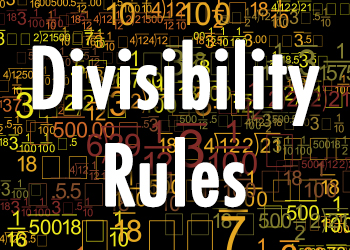
When it comes time for your children to divide with big numbers (something I’m sure they look forward too), divisibility rules can make the job a bit easier. These rules will tell your child whether a particular number will divide evenly into another number.
For teens, the divisibility rules can be useful when they need to factor large numbers in algebraic expressions. They can test possibilities to find out in what ways a given number can be divided up.
Below are the divisibility rules for numbers 2 through 10. (1 isn’t included because it’s just too easy. 😉 ) These rules are free for the taking. With any luck, they’ll help your child or teen learn to divide and conquer in the math world.
Divisibility Rules
A number is divisible by 2 if the number is even, meaning that it ends in 0, 2, 4, 6, 8.
A number is divisible by 3 if the sum of the digits of the number is divisible by 3.
A number is divisible by 4 if the number is even and the last two digits of the number are divisible by 4.
A number is divisible by 5 if the number ends in 0 or 5.
A number is divisible by 6 if the number is even and the sum of its digits are divisible by 3.
A number is divisible by 7 if you double the last digit and subtract it from the rest of the number and end up with a number that is divisible by 7.
A number is divisible by 8 if the number formed by the last three digits of the number is divisible by 8.
A number is divisible by 9 if the sum of the digits are divisible by 9.
A number is divisible by 10 if the number ends in 0.
I hope your child or teen found these divisibility rules helpful. If you have any friends with children in need of these rules, feel free to share them using the buttons below.






